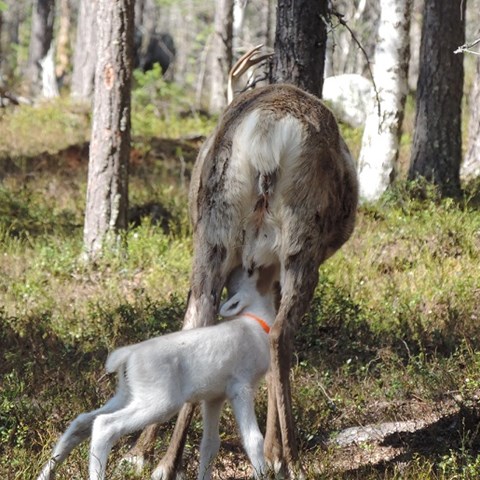Contact
Department of Applied Animal Science and Welfare, Reindeer Husbandry

The depredation of semi-domesticated reindeer by large carnivores reflects an important human–wildlife conflict in Fennoscandia. Recent studies have revealed that brown bears (Ursus arctos) may kill substantial numbers of reindeer calves (Rangifer tarandus tarandus) in forest areas in Sweden.
Several authors have suggested that predation risk is an important driver of habitat selection in wild Rangifer populations where predation is a limiting factor, but little is known about these mechanisms in semi-domesticated populations.
We examined the habitat selection of female reindeer in relation to spatial and temporal variations in brown bear predation risk on the reindeer calving grounds and evaluated the simultaneous responses of brown bears and reindeer to landscape characteristics. We used GPS data from 110 reindeer years (97 individuals) and 29 brown bear years (19 individuals), from two reindeer herding districts in the forest area of northern Sweden.
Our results did not indicate that reindeer alter their behavior in response to spatiotemporal variation in brown bear predation risk, on the scale of the calving range. Instead, we suggest that spatiotemporal behavioral adjustments by brown bears were the main driver of prey–predator interactions in our study system. Contrasting responses by brown bears and reindeer to clear-cuts and young forest indicate that forestry can influence species interactions and possibly yield negative consequences for the reindeer herd. Even if clear-cuts may be beneficial in terms of calf survival, logging activity will eventually cause greater abundance of young regenerating forest, reducing available reindeer habitats and increasing habitat preferred by brown bears. Domestication may have made semi-domesticated reindeer in Fennoscandia less adapted to cope with predators. Areal restrictions, limiting the opportunity for dispersion and escape, possibly make the calves more susceptible to predation. Also, a generally higher population density in semi-domesticated herds compared to wild populations can make dispersion a less efficient strategy and the reindeer calves easier prey.
Overall, the lack of ability of the reindeer females to reduce brown bear encounter risk on the scale of the calving range is probably an important reason for the high brown bear predation rates on reindeer calves documented in our study areas.
http://onlinelibrary.wiley.com/doi/10.1002/ecs2.1583/abstract
Sivertsen, T. R., B. Åhman, S. M. J. G. Steyaert, L. Rönnegård, J. Frank, P. Segerström, O.-G. Støen, and A. Skarin. 2016. Reindeer habitat selection under the risk of brown bear predation during calving season. Ecosphere 7(11). DOI: 10.1002/ecs2.1583